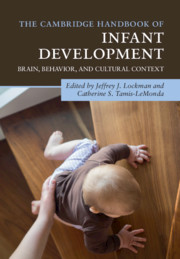Book contents
- The Cambridge Handbook of Infant Development
- The Cambridge Handbook of Infant Development
- Copyright page
- Dedication
- Contents
- Illustrations
- Contributors
- Preface
- Part I Foundations
- Part II Perceptual Development
- Part III Cognitive Development
- Part IV Action
- Part V Language
- Part VI Emotional and Social Development
- 25 Infant Attachment (to Mother and Father) and Its Place in Human Development
- 26 Infant Emotion Development and Temperament
- 27 Infant Emotional Development
- 28 Understanding and Evaluating the Moral World in Infancy
- 29 Cross-Cultural Perspectives on Parent–Infant Interactions
- Index
- References
26 - Infant Emotion Development and Temperament
from Part VI - Emotional and Social Development
Published online by Cambridge University Press: 26 September 2020
- The Cambridge Handbook of Infant Development
- The Cambridge Handbook of Infant Development
- Copyright page
- Dedication
- Contents
- Illustrations
- Contributors
- Preface
- Part I Foundations
- Part II Perceptual Development
- Part III Cognitive Development
- Part IV Action
- Part V Language
- Part VI Emotional and Social Development
- 25 Infant Attachment (to Mother and Father) and Its Place in Human Development
- 26 Infant Emotion Development and Temperament
- 27 Infant Emotional Development
- 28 Understanding and Evaluating the Moral World in Infancy
- 29 Cross-Cultural Perspectives on Parent–Infant Interactions
- Index
- References
Summary
Caregivers of young infants are often well practiced in detecting and interpreting the presence or absence of infant emotion. This is particularly true in the case of negative emotions, motivating caregivers to take on the mantel of detective. Why is the baby crying? Is he/she hungry? Cold? Too hot? Angry? Gassy? Tired? Bored? A caregiver’s need to search for clues reflects infants’ rather limited communicative repertoire, coupled with a restricted behavioral toolbox. Over the first 2 years of life, children’s expression and experience of emotion becomes more expansive, providing greater insight into the cause of any one emotional experience and the needed response. However, even at this point, parents and caregivers play an important role in modulating infants’ emotional experiences, since much of emotion regulation is first implemented externally until the child can internalize and develop effective stand-alone regulatory responses.
Keywords
- Type
- Chapter
- Information
- The Cambridge Handbook of Infant DevelopmentBrain, Behavior, and Cultural Context, pp. 715 - 741Publisher: Cambridge University PressPrint publication year: 2020
References
- 3
- Cited by



